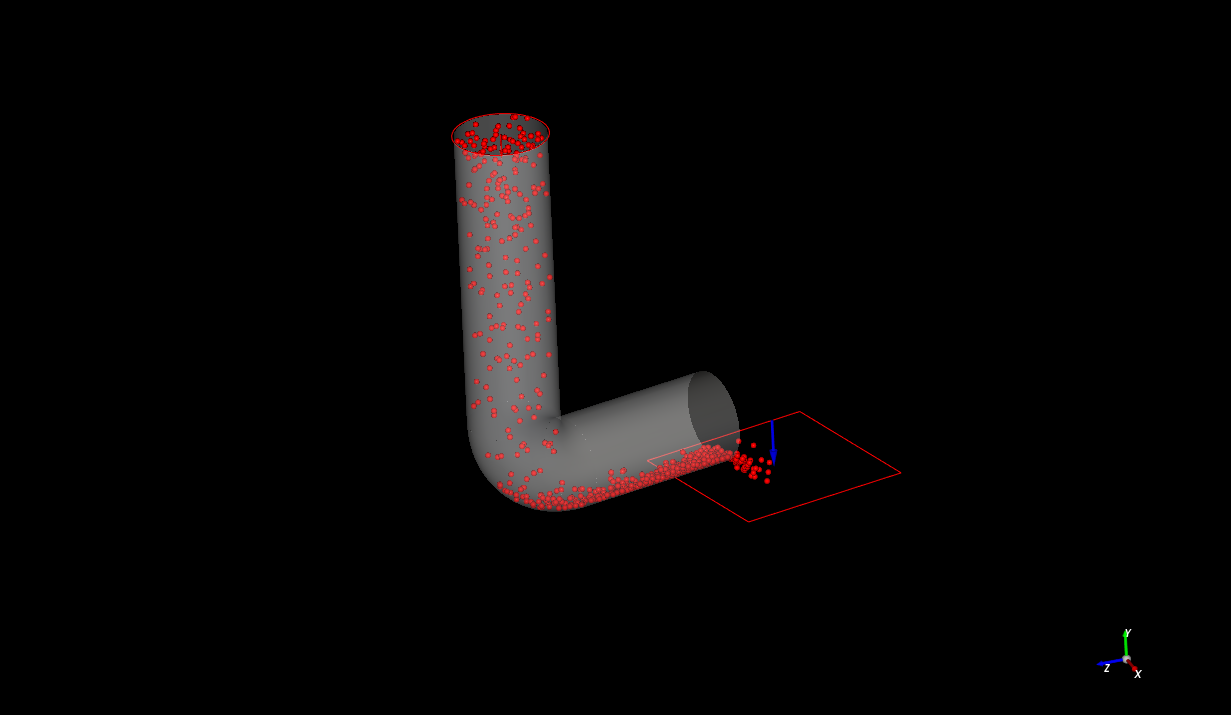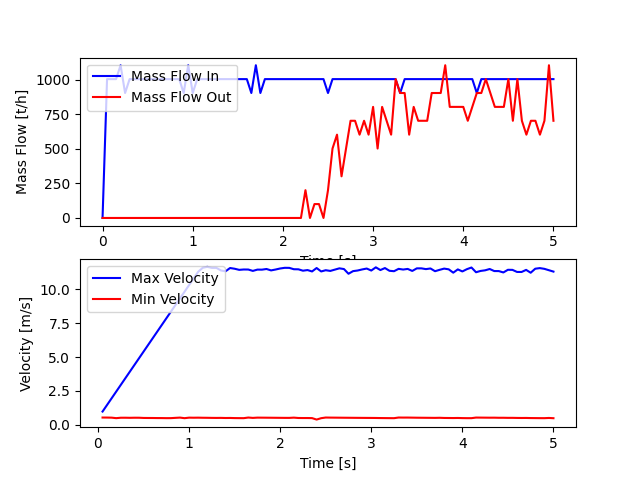Note
Go to the end to download the full example code.
Particle simulation with moving wall interaction#
This example sets up and solves a simulation of particles interacting with a rotating L-shape tube wall.

Perform imports and create a project#
Perform the required imports and create an empty project.
import os.path
import tempfile
import ansys.rocky.core as pyrocky
from ansys.rocky.core import examples
# Temporarily pin to v252 because next version is failing on Pyro connection
ROCKY_VERSION = 252
# Create a temp directory to save the project.
project_dir = tempfile.mkdtemp(prefix="pyrocky_")
# Launch Rocky and open a project.
rocky = pyrocky.launch_rocky(rocky_version=ROCKY_VERSION)
project = rocky.api.CreateProject()
project.SaveProject(os.path.join(project_dir, "rocky-testing.rocky"))
Configure the study#
study = project.GetStudy()
# Download the STL file that was imported into Rocky to represent a wall.
file_name = "Lshape_tube.stl"
file_path = examples.download_file(project_dir, file_name, "pyrocky/geometries")
wall = study.ImportWall(file_path)[0]
# Create a particle with the default shape (sphere) and size distribution (single
# distribution with a sieve size of 0.1 m).
particle = study.CreateParticle()
# Create a circular surface to used as the inlet.
circular_surface = study.CreateCircularSurface()
circular_surface.SetMaxRadius(0.8, unit="m")
# Create a rectangular surface to use as the outlet.
rectangular_surface = study.CreateRectangularSurface()
rectangular_surface.SetLength(3, unit="m")
rectangular_surface.SetWidth(3, unit="m")
rectangular_surface.SetCenter((5, -7.5, 0), unit="m")
# Set the inlet and outlet.
particle_inlet = study.CreateParticleInlet(circular_surface, particle)
input_property_list = particle_inlet.GetInputPropertiesList()
input_property_list[0].SetMassFlowRate(1000)
outlet = study.CreateOutlet(rectangular_surface)
# Set the motion rotation over the Y axis and apply it on the wall and the
# rectagular surface used as the outlet.
motion_frame_source = study.GetMotionFrameSource()
motion_frame = motion_frame_source.NewFrame()
motion_frame.AddRotationMotion(angular_velocity=((0.0, 0.5, 0.0), "rad/s"))
motion_frame.ApplyTo(rectangular_surface)
motion_frame.ApplyTo(wall)
# The domain settings define the domain limits where the particles are enabled to be
# computed in the simulation.
domain = study.GetDomainSettings()
domain.DisableUseBoundaryLimits()
domain.SetCoordinateLimitsMaxValues((10, 1, 10), unit="m")
Download successful. File path:
C:\Users\ansys\AppData\Local\Temp\pyrocky_f0gplfo8\Lshape_tube.stl
Set up the solver and run the simulation#
solver = study.GetSolver()
solver.SetSimulationDuration(5, unit="s")
study.StartSimulation()
True
Postprocess#
Obtain the in and out mass flows of the particles.
particles = study.GetParticles()
times, mass_flow_in = particles.GetNumpyCurve("Particles Mass Flow In", unit="t/h")
times, mass_flow_out = particles.GetNumpyCurve("Particles Mass Flow Out", unit="t/h")
# Obtain the maximum and minimum velocities of the particles at each time step.
import numpy as np
simulation_times = study.GetTimeSet()
velocity_gf = particles.GetGridFunction("Velocity : Translational : Absolute")
velocity_max = np.array(
[velocity_gf.GetMax(unit="m/s", time_step=i) for i in range(len(simulation_times))]
)
velocity_min = np.array(
[velocity_gf.GetMin(unit="m/s", time_step=i) for i in range(len(simulation_times))]
)
Plot curves#
import matplotlib.pyplot as plt
fig, (ax1, ax2) = plt.subplots(2, 1)
ax1.plot(times, mass_flow_in, "b", label="Mass Flow In")
ax1.plot(times, mass_flow_out, "r", label="Mass Flow Out")
ax1.set_xlabel("Time [s]")
ax1.set_ylabel("Mass Flow [t/h]")
ax1.legend(loc="upper left")
ax2.plot(simulation_times, velocity_max, "b", label="Max Velocity")
ax2.plot(simulation_times, velocity_min, "r", label="Min Velocity")
ax2.set_xlabel("Time [s]")
ax2.set_ylabel("Velocity [m/s]")
ax2.legend(loc="upper left")
plt.draw()
rocky.close()

Total running time of the script: (1 minutes 2.549 seconds)

